The electrogenic sodium bicarbonate cotransporter: developmental expression in rat brain and possible role in acid vulnerability
- PMID: 10648705
- PMCID: PMC6774156
- DOI: 10.1523/JNEUROSCI.20-03-01001.2000
The electrogenic sodium bicarbonate cotransporter: developmental expression in rat brain and possible role in acid vulnerability
Abstract
The electrogenic sodium bicarbonate cotransporter (NBC) is expressed in glial cells in the brain and plays an important role in the regulation of both intracellular and extracellular pH. Differential vulnerability to acidosis between neurons and glia has been noted and may contribute to infarction after cerebral ischemia. Ionic substitution studies and inhibition of injury by 4, 4'-di-isothiocyanostilbene-2,2'-disulfonic acid suggest that NBC is involved in astrocyte vulnerability to acidic injury. Recently two NBC cDNAs differing in 5'-untranslated and N-terminal coding sequence have been cloned from kidney and pancreas. We cloned one of these cDNAs from rat brain and demonstrate here that the clone is functional by expression in Xenopus oocytes. We determined the developmental and regional expression of NBC in the brain by in situ hybridization. Expression was observed in the spinal cord at embryonic day 17, whereas expression in brain was first seen at approximately postnatal day 0 (P0), increased at P15, and persisted in the adult brain. Expression was widespread throughout the cerebellum, cortex, olfactory bulb, and subcortical structures. Cellular resolution of the in situ hybridization signal and double labeling for glial fibrillary acidic protein were consistent with a glial localization for NBC. Expression of NBC in 3T3 cells that do not normally express this transporter rendered them vulnerable to acid injury. The expression profile suggests that this transporter is critical during the later stages of brain development and could be one of the factors contributing to the different patterns of injury seen in perinatal versus adult cerebral ischemia.
Figures
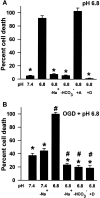

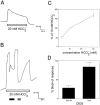
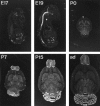
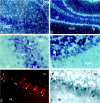
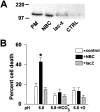
Similar articles
-
Na/HCO3 cotransporters in rat brain: expression in glia, neurons, and choroid plexus.J Neurosci. 2000 Sep 15;20(18):6839-48. doi: 10.1523/JNEUROSCI.20-18-06839.2000. J Neurosci. 2000. PMID: 10995828 Free PMC article.
-
An electrogenic Na(+)-HCO(-)(3) cotransporter (NBC) with a novel COOH-terminus, cloned from rat brain.Am J Physiol Cell Physiol. 2000 Jun;278(6):C1200-11. doi: 10.1152/ajpcell.2000.278.6.C1200. Am J Physiol Cell Physiol. 2000. PMID: 10837348
-
Mouse Na+: HCO3- cotransporter isoform NBC-3 (kNBC-3): cloning, expression, and renal distribution.Kidney Int. 2001 Apr;59(4):1405-14. doi: 10.1046/j.1523-1755.2001.0590041405.x. Kidney Int. 2001. PMID: 11260402
-
The electrogenic Na+/HCO3- cotransporter, NBC.JOP. 2001 Jul;2(4 Suppl):182-91. JOP. 2001. PMID: 11875257 Review.
-
Electrogenic Na+/HCO3- cotransporters: cloning and physiology.Annu Rev Physiol. 1999;61:699-723. doi: 10.1146/annurev.physiol.61.1.699. Annu Rev Physiol. 1999. PMID: 10099707 Review.
Cited by
-
The divergence, actions, roles, and relatives of sodium-coupled bicarbonate transporters.Physiol Rev. 2013 Apr;93(2):803-959. doi: 10.1152/physrev.00023.2012. Physiol Rev. 2013. PMID: 23589833 Free PMC article. Review.
-
Facilitated lactate transport by MCT1 when coexpressed with the sodium bicarbonate cotransporter (NBC) in Xenopus oocytes.Biophys J. 2004 Jan;86(1 Pt 1):235-47. doi: 10.1016/S0006-3495(04)74099-0. Biophys J. 2004. PMID: 14695265 Free PMC article.
-
Exacerbation of Epilepsy by Astrocyte Alkalization and Gap Junction Uncoupling.J Neurosci. 2021 Mar 10;41(10):2106-2118. doi: 10.1523/JNEUROSCI.2365-20.2020. Epub 2021 Jan 21. J Neurosci. 2021. PMID: 33478985 Free PMC article.
-
Optogenetic approaches addressing extracellular modulation of neural excitability.Sci Rep. 2016 Apr 5;6:23947. doi: 10.1038/srep23947. Sci Rep. 2016. PMID: 27045897 Free PMC article.
-
Ionic transporter activity in astrocytes, microglia, and oligodendrocytes during brain ischemia.J Cereb Blood Flow Metab. 2013 Jul;33(7):969-82. doi: 10.1038/jcbfm.2013.44. Epub 2013 Apr 3. J Cereb Blood Flow Metab. 2013. PMID: 23549380 Free PMC article. Review.
References
-
- Abuladze N, Lee I, Newman D, Hwang J, Boorer K, Pushkin A, Kurtz I. Molecular cloning, chromosomal localization, tissue distribution, and functional expression of the human pancreatic sodium bicarbonate cotransporter. J Biol Chem. 1998;273:17689–17695. - PubMed
-
- Bing OH, Brooks WW, Messer JV. Heart muscle viability following hypoxia: protective effect of acidosis. Science. 1973;180:1297–1298. - PubMed
-
- Burnham CE, Amlal H, Wang Z, Shull GE, Soleimani M. Cloning and functional expression of a human kidney Na+:HCO3-cotransporter. J Biol Chem. 1997;272:19111–19114. - PubMed
Publication types
MeSH terms
Substances
Associated data
- Actions
Grants and funding
LinkOut - more resources
Full Text Sources
Medical
Molecular Biology Databases
